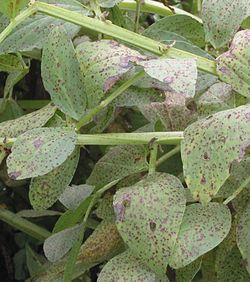Difference between revisions of "AY Honors/Fungi/Botryotinia/es"
From Pathfinder Wiki
(Created page with "Libro de Respuestas de Especialidades JA/Naturaleza/Hongos/Botrytis") |
(Updating to match new version of source page) |
||
| (3 intermediate revisions by one other user not shown) | |||
| Line 1: | Line 1: | ||
| − | <noinclude></noinclude> | + | <noinclude><div lang="en" dir="ltr" class="mw-content-ltr"> |
| + | </noinclude> | ||
[[Image:Tuinboon Chocoladevlekkenziekte.jpg|thumb|180px|Botrytis]] | [[Image:Tuinboon Chocoladevlekkenziekte.jpg|thumb|180px|Botrytis]] | ||
Botryotinia is a genus of ascomycete fungi causing several plant diseases. The anamorphs (asexual reproductive stage) of Botryotinia are mostly included in the imperfect fungi genus Botrytis. The genus contains 22 species and one hybrid. | Botryotinia is a genus of ascomycete fungi causing several plant diseases. The anamorphs (asexual reproductive stage) of Botryotinia are mostly included in the imperfect fungi genus Botrytis. The genus contains 22 species and one hybrid. | ||
| + | </div> | ||
| + | <div lang="en" dir="ltr" class="mw-content-ltr"> | ||
Plant diseases caused by Botryotinia species appear primarily as blossom blights and fruit rots but also as leaf spots and bulb rots in the field and in stored products. The fungi induce host-cell death resulting in progressive decay of infected plant tissue, whence they take nutrients. | Plant diseases caused by Botryotinia species appear primarily as blossom blights and fruit rots but also as leaf spots and bulb rots in the field and in stored products. The fungi induce host-cell death resulting in progressive decay of infected plant tissue, whence they take nutrients. | ||
| − | <noinclude></noinclude> | + | <noinclude> |
| − | + | </div></noinclude> | |
Latest revision as of 23:16, 14 July 2022
Botryotinia is a genus of ascomycete fungi causing several plant diseases. The anamorphs (asexual reproductive stage) of Botryotinia are mostly included in the imperfect fungi genus Botrytis. The genus contains 22 species and one hybrid.
Plant diseases caused by Botryotinia species appear primarily as blossom blights and fruit rots but also as leaf spots and bulb rots in the field and in stored products. The fungi induce host-cell death resulting in progressive decay of infected plant tissue, whence they take nutrients.

